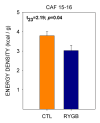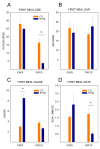Meal Patterns and Food Choices of Female Rats Fed a Cafeteria-Style Diet Are Altered by Gastric Bypass Surgery
- PMID: 34836110
- PMCID: PMC8623594
- DOI: 10.3390/nu13113856
Meal Patterns and Food Choices of Female Rats Fed a Cafeteria-Style Diet Are Altered by Gastric Bypass Surgery
Abstract
After Roux-en-Y gastric bypass surgery (RYGB), rats tend to reduce consumption of high-sugar and/or high-fat foods over time. Here, we sought to investigate the behavioral mechanisms underlying these intake outcomes. Adult female rats were provided a cafeteria diet comprised of five palatable foodstuffs varying in sugar and fat content and intake was monitored continuously. Rats were then assigned to either RYGB, or one of two control (CTL) groups: sham surgery or a nonsurgical control group receiving the same prophylactic iron treatments as RYGB rats. Post-sur-gically, all rats consumed a large first meal of the cafeteria diet. After the first meal, RYGB rats reduced intake primarily by decreasing the meal sizes relative to CTL rats, ate meals more slowly, and displayed altered nycthemeral timing of intake yielding more daytime meals and fewer nighttime meals. Collectively, these meal patterns indicate that despite being motivated to consume a cafeteria diet after RYGB, rats rapidly learn to modify eating behaviors to consume foods more slowly across the entire day. RYGB rats also altered food preferences, but more slowly than the changes in meal patterns, and ate proportionally more energy from complex carbohydrates and protein and proportionally less fat. Overall, the pattern of results suggests that after RYGB rats quickly learn to adjust their size, eating rate, and distribution of meals without altering meal number and to shift their macronutrient intake away from fat; these changes appear to be more related to postingestive events than to a fundamental decline in the palatability of food choices.
Keywords: Roux-en-Y gastric bypass; cafeteria diet; food choice; macronutrient selection; meal pattern analysis; rat.
Conflict of interest statement
The authors declare no conflict of interest.
Figures


















Similar articles
-
Early Postoperative Exposure to High-Fat Diet Does Not Increase Long-Term Weight Loss or Fat Avoidance After Roux-en-Y Gastric Bypass in Rats.Front Nutr. 2022 Apr 13;9:834854. doi: 10.3389/fnut.2022.834854. eCollection 2022. Front Nutr. 2022. PMID: 35495960 Free PMC article.
-
A Comparison of Total Food Intake at a Personalised Buffet in People with Obesity, before and 24 Months after Roux-en-Y-Gastric Bypass Surgery.Nutrients. 2021 Oct 29;13(11):3873. doi: 10.3390/nu13113873. Nutrients. 2021. PMID: 34836130 Free PMC article.
-
Roux-en-Y gastric bypass in rats progressively decreases the proportion of fat calories selected from a palatable cafeteria diet.Am J Physiol Regul Integr Comp Physiol. 2016 May 15;310(10):R952-9. doi: 10.1152/ajpregu.00444.2015. Epub 2016 Feb 10. Am J Physiol Regul Integr Comp Physiol. 2016. PMID: 26864811 Free PMC article.
-
Hedonic Changes in Food Choices Following Roux-en-Y Gastric Bypass.Obes Surg. 2016 Aug;26(8):1946-55. doi: 10.1007/s11695-016-2217-x. Obes Surg. 2016. PMID: 27173820 Review.
-
Taste- and flavor-guided behaviors following Roux-en-Y gastric bypass in rodent models.Appetite. 2020 Mar 1;146:104422. doi: 10.1016/j.appet.2019.104422. Epub 2019 Aug 28. Appetite. 2020. PMID: 31472198 Review.
Cited by
-
A new apparatus to analyze meal-related ingestive behaviors in rats fed a complex multi-food diet.Physiol Behav. 2022 Aug 1;252:113824. doi: 10.1016/j.physbeh.2022.113824. Epub 2022 Apr 25. Physiol Behav. 2022. PMID: 35472328 Free PMC article.
-
The Nature of Available Choices Affects the Intake and Meal Patterns of Rats Offered a Palatable Cafeteria-Style Diet.Nutrients. 2023 Dec 13;15(24):5093. doi: 10.3390/nu15245093. Nutrients. 2023. PMID: 38140351 Free PMC article.
-
Macronutrient intake: Hormonal controls, pathological states, and methodological considerations.Appetite. 2023 Jan 1;180:106365. doi: 10.1016/j.appet.2022.106365. Epub 2022 Nov 5. Appetite. 2023. PMID: 36347305 Free PMC article. Review.
-
Weight loss in adult male Wistar rats by Roux-en-Y gastric bypass is primarily explained by caloric intake reduction and presurgery body weight.Am J Physiol Regul Integr Comp Physiol. 2024 Jun 1;326(6):R507-R514. doi: 10.1152/ajpregu.00169.2023. Epub 2024 Apr 8. Am J Physiol Regul Integr Comp Physiol. 2024. PMID: 38586888 Free PMC article.
-
Early Postoperative Exposure to High-Fat Diet Does Not Increase Long-Term Weight Loss or Fat Avoidance After Roux-en-Y Gastric Bypass in Rats.Front Nutr. 2022 Apr 13;9:834854. doi: 10.3389/fnut.2022.834854. eCollection 2022. Front Nutr. 2022. PMID: 35495960 Free PMC article.
References
-
- Sjöström L., Lindroos A.-K., Peltonen M., Torgerson J., Bouchard C., Carlsson B., Dahlgren S., Larsson B., Narbro K., Sjöström C.D., et al. Lifestyle, Diabetes, and Cardiovascular Risk Factors 10 Years after Bariatric Surgery. N. Engl. J. Med. 2004;351:2683–2693. doi: 10.1056/NEJMoa035622. - DOI - PubMed
MeSH terms
Grants and funding
LinkOut - more resources
Full Text Sources
Research Materials

